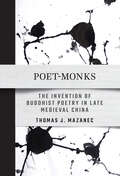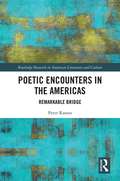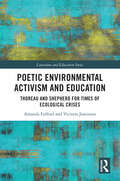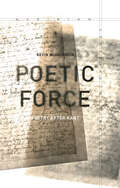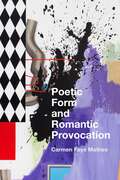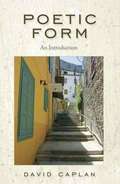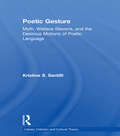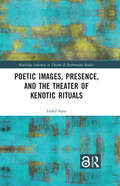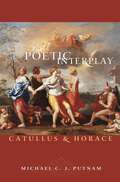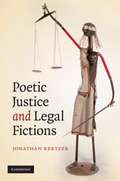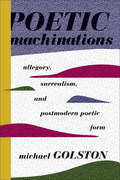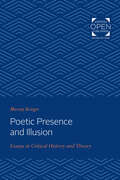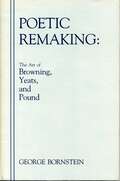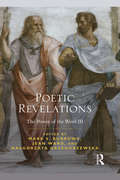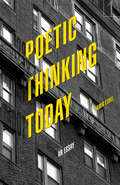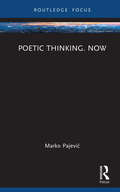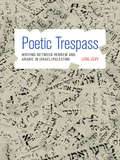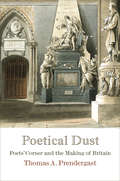- Table View
- List View
Poet-Monks: The Invention of Buddhist Poetry in Late Medieval China
by Thomas J. MazanecPoet-Monks focuses on the literary and religious practices of Buddhist poet-monks in Tang-dynasty China to propose an alternative historical arc of medieval Chinese poetry. Combining large-scale quantitative analysis with close readings of important literary texts, Thomas J. Mazanec describes how Buddhist poet-monks, who first appeared in the latter half of Tang-dynasty China, asserted a bold new vision of poetry that proclaimed the union of classical verse with Buddhist practices of repetition, incantation, and meditation.Mazanec traces the historical development of the poet-monk as a distinct actor in the Chinese literary world, arguing for the importance of religious practice in medieval literature. As they witnessed the collapse of the world around them, these monks wove together the frayed threads of their traditions to establish an elite-style Chinese Buddhist poetry. Poet-Monks shows that during the transformative period of the Tang-Song transition, Buddhist monks were at the forefront of poetic innovation.
Poetic Community
by Stephen VoycePoetic Community examines the relationship between poetry and community formation in the decades after the Second World War. In four detailed case studies (of Black Mountain College in North Carolina, the Caribbean Artists Movement in London, the Women's Liberation Movement at sites throughout the US, and the Toronto Research Group in Canada) the book documents and compares a diverse group of social models, small press networks, and cultural coalitions informing literary practice during the Cold War era.Drawing on a wealth of unpublished archival materials, Stephen Voyce offers new and insightful comparative analysis of poets such as John Cage, Charles Olson, Adrienne Rich, Kamau Brathwaite, and bpNichol. In contrast with prevailing critical tendencies that read mid-century poetry in terms of expressive modes of individualism, Poetic Community demonstrates that the most important literary innovations of the post-war period were the results of intensive collaboration and social action opposing the Cold War's ideological enclosures.
Poetic Encounters in the Americas: Remarkable Bridge (Routledge Research in American Literature and Culture)
by Peter RamosPoetic Encounters in the Americas: Remarkable Bridge examines the ways in which U.S. and Latin American modernist canons have been in cross-cultural, mutually enabling conversation, especially through the act of literary translation. Examining eighteen U.S. and Latin American poets, my book is one of the few works of criticism to present case studies in U.S. and Latin American poetries in dialogues that highlight the social life and imaginative encounters obtained through methodologies of translation and innovations in poetic technique.
Poetic Environmental Activism and Education: Thoreau and Shepherd for Times of Ecological Crises (Literature and Education)
by Amanda Fulford Victoria JamiesonThis book brings together the works of the nineteenth and twentieth century writers Henry David Thoreau and Anna Shepherd. Finding in their work a common approach of poetic forms of writing that enact kinds of environmental activism, the book re-positions them in the context of current environmental crises by offering an original resource for supporting poetic environmental activism in educational contexts.Bringing together scholarship from North America and Europe, the book draws on Thoreau and Shepherd’s literary and philosophical sources to support a conceptual understanding of education’s role in how we think about, understand, and tackle the climate crisis. Chapters trace the idea of poetic environmental activism in Thoreau and Shepherd, applying literary and environmental thought to educational practice and contexts. The book is timely in taking a scholarly approach that explores educational engagements with climate change and focuses on education for environmental sustainability.Advocating for engagement with the climate emergency through the lens of poetic environmental activism, this volume will appeal to postgraduate students, researchers, and scholars involved with sustainability education, philosophy of education, poetic inquiry, and literary theory for environmental action.
Poetic Force: Poetry After Kant
by Kevin MclaughlinThis book argues that the theory of force elaborated in Immanuel Kant's aesthetics (and in particular, his theorization of the dynamic sublime) is of decisive importance to poetry in the nineteenth century and to the connection between poetry and philosophy over the last two centuries. Inspired by his deep engagement with the critical theory of Walter Benjamin, who especially developed this Kantian strain of thinking, Kevin McLaughlin uses this theory of force to illuminate the work of three of the most influential nineteenth-century writers in their respective national traditions: Friedrich Hölderlin, Charles Baudelaire, and Matthew Arnold. The result is a fine elucidation of Kantian theory and a fresh account of poetic language and its aesthetic, ethical, and political possibilities.
Poetic Form and Romantic Provocation
by Carmen Faye MathesCritics have long understood the development of Romantic aesthetics as a turning point in the history of literary theory, a turn that is responsible for theories of mind and body that continue to inform our understandings of subjectivity and embodiment today. Yet the question of what aesthetic experience can "do" grates against the fact that much Romantic writing represents subjects as not actually in charge of the feelings they feel, the dreams they dream, or the actions they take. In response to this dilemma, Poetic Form and Romantic Provocation argues that being moved contrary to one's will is itself an aesthetic phenomenon explored by Romantic poets whose experiments with poetic form and genre provoke unanticipated feelings through verse. By analyzing how Romantic poets intervene, affectively and aesthetically, in readerly expectations of form and genre, Mathes shows how provocations disrupt and invite, disturb and compel—interrupting or suspending or retreating in ways that ask readers to orient themselves, materially and socially, in relation to literary experiences that are at once virtual and embodied. Examining the formal tactics of Charlotte Smith, William Wordsworth, Samuel Taylor Coleridge, John Keats, and Percy Bysshe Shelley, alongside their reactions to historical events such as Toussaint Louverture's revolt and the Peterloo Massacre, Mathes reveals that an aesthetics of radical openness is central to the development of literary theory and criticism in Romantic Britain.
Poetic Form: An Introduction
by David CaplanWriting exercises challenge students to utilize the forms in creative expression. Covering a wider range of forms in greater detail and with more poetic examples than similar guides on the market, it provides enough material to thoroughly introduce the language's major forms while allowing flexibility in the classroom.
Poetic Gesture: Myth, Wallace Stevens, and the Desirous Motions of Poetic Language (Literary Criticism and Cultural Theory)
by Kristine S. SantilliFirst Published in 2003. Routledge is an imprint of Taylor & Francis, an informa company.
Poetic Images, Presence, and the Theater of Kenotic Rituals (Routledge Advances in Theatre & Performance Studies)
by Eniko SepsiThis book explores the interrelation of contemporary French theatre and poetry. Using the pictorial turn in the various branches of art and science, its observable features, and the theoretical framework of the conceptual metaphor, this study seeks to gather together the divergent manners in which French poetry and theatre address this turn. Poetry in space and theatricality of poetry are studied alongside theatre, especially to the performative aspect of the originally theological concept of "kenosis". In doing so the author attempts to make use of the theological concept of kenosis, of central importance in Novarina’s oeuvre, for theatrical and dramatological purposes. Within poetic rituals, kenotic rituals are also examined in the book in a few theatrical practices – János Pilinszky and Robert Wilson, Jerzy Grotowski and Eugenio Barba – facilitating a better understanding of Novarina’s works. Accompanied by new English translations in the appendices, this is the first English language monograph related to the French essayist, dramaturg and director Valère Novarina’s theatre, and will be of great interest to students and scholars in theatre and literature studies.
Poetic Interplay: Catullus and Horace (Martin Classical Lectures #17)
by Michael C.J. PutnamThe lives of Catullus and Horace overlap by a dozen years in the first century BC. Yet, though they are the undisputed masters of the lyric voice in Roman poetry, Horace directly mentions his great predecessor, Catullus, only once, and this reference has often been taken as mocking. In fact, Horace's allusion, far from disparaging Catullus, pays him a discreet compliment by suggesting the challenge that his accomplishment presented to his successors, including Horace himself. In Poetic Interplay, the first book-length study of Catullus's influence on Horace, Michael Putnam shows that the earlier poet was probably the single most important source of inspiration for Horace's Odes, the later author's magnum opus. Except in some half-dozen poems, Catullus is not, technically, writing lyric because his favored meters do not fall into that category. Nonetheless, however disparate their preferred genres and their stylistic usage, Horace found in the poetry of Catullus, whatever its mode of presentation, a constant stimulus for his imagination. And, despite the differences between the two poets, Putnam's close readings reveal that many of Horace's poems echo Catullus verbally, thematically, or both. By illustrating how Horace often found his own voice even as he acknowledged Catullus's genius, Putnam guides us to a deeper appreciation of the earlier poet as well.
Poetic Justice and Legal Fictions
by Jonathan KertzerLiterature reveals the intense efforts of moral imagination required to articulate what justice is and how it might be satisfied. Examining a wide variety of texts including Shakespeare's plays, Gilbert and Sullivan's operas, and modernist poetics, Poetic Justice and Legal Fictions explores how literary laws and values illuminate and challenge the jurisdiction of justice and the law. Jonathan Kertzer examines how justice is articulated by its command of, or submission to, time, nature, singularity, truth, transcendence and sacrifice, marking the distance between the promise of justice to satisfy our moral and sociable needs and its failure to do so. Poetic Justice and Legal Fictions will be invaluable reading for scholars of the law within literature and amongst modernist and twentieth century literature specialists.
Poetic Language and Political Engagement in the Poetry of Keats (Studies in Major Literary Authors)
by Jack L. SilerIn this incisive volume Siler traces the uneasy relationship between the content of Keats' poems and social history. In the process, he discovers that the early poems are linked with the mission statement of the radical journal Annals of the Fine Arts, whilst the poems after Endymion reveal a poet more concerned with the nature of poetic representation--its why and wherefore.
Poetic Logic and the Origins of the Mathematical Imagination (Mathematics in Mind)
by Marcel DanesiThis book treats eighteenth-century Italian philosopher Giambattista Vico’s theory of poetic logic for the first time as the originating force in mathematics, transforming instinctive counting and spatial perception into poetic (metaphorical) symbolism that dovetails with the origin of language. It looks at current work on mathematical cognition (from Lakoff and Núñez to Butterworth, Dehaene, and beyond), matching it against the poetic logic paradigm. In a sense, it continues from where Kasner and Newman left off, connecting contemporary research on the mathematical mind to the idea that the products of early mathematics were virtually identical to the first forms of poetic language. As such, this book informs the current research on mathematical cognition from a different angle, by looking back at a still relatively unknown philosopher within mathematics.The aim of this volume is to look broadly at what constitutes the mathematical mind through the Vichian lens of poetic logic. Vico was among the first to suggest that the essential nature of mind could be unraveled indirectly by reconstructing the sources of its “modifications” (his term for “creations”); that is, by examining the creation and function of symbols, words, and all the other uniquely human artifacts—including mathematics—the mind has allowed humans to establish “the world of civil society,” Vico’s term for culture and civilization.The book is of interest to cognitive scientists working on math cognition. It presents the theory of poetic logic as Vico articulated it in his book The New Science, examining its main premises and then applying it to an interpretation of the ongoing work in math cognition. It will also be of interest to the general public, since it presents a history of early mathematics through the lens of an idea that has borne fruit in understanding the origin of language and symbols more broadly.
Poetic Machinations
by Michael GolstonThe shape, lineation, and prosody of postmodern poems are extravagantly inventive, imbuing their form with as much meaning as their content. Through a survey of American poetry and poetics from the end of World War II to the present, Michael Golston traces the proliferation of these experiments to a growing fascination with allegory in philosophy, linguistics, critical theory, and aesthetics, introducing new strategies for reading American poetry while embedding its formal innovations within the history of intellectual thought.Beginning with Walter Benjamin's explicit understanding of Surrealism as an allegorical art, Golston defines a distinct engagement with allegory among philosophers, theorists, and critics from 1950 to today. Reading Fredric Jameson, Angus Fletcher, Roland Barthes, and Craig Owens, and working with the semiotics of Charles Sanders Pierce, Golston develops a theory of allegory he then applies to the poems of Louis Zukofsky and Lorine Niedecker, who, he argues, wrote in response to the Surrealists; the poems of John Ashbery and Clark Coolidge, who incorporated formal aspects of filmmaking and photography into their work; the groundbreaking configurations of P. Inman, Lyn Hejinian, Myung Mi Kim, and the Language poets; Susan Howe's "Pierce-Arrow," which he submits to semiotic analysis; and the innovations of Craig Dworkin and the conceptualists. Revitalizing what many consider to be a staid rhetorical trope, Golston positions allegory as a creative catalyst behind postwar American poetry's avant-garde achievements.
Poetic Machinations: Allegory, Surrealism, and Postmodern Poetic Form
by Michael GolstonThe shape, lineation, and prosody of postmodern poems are extravagantly inventive, imbuing both form and content with meaning. Through a survey of American poetry and poetics from the end of World War II to the present, Michael Golston traces the proliferation of these experiments to a growing fascination with allegory in philosophy, linguistics, critical theory, and aesthetics, introducing new strategies for reading American poetry while embedding its formal innovations within the history of intellectual thought.Beginning with Walter Benjamin's explicit understanding of Surrealism as an allegorical art, Golston defines a distinct engagement with allegory among philosophers, theorists, and critics from 1950 to today. Reading Fredric Jameson, Angus Fletcher, Roland Barthes, and Craig Owens, and working with the semiotics of Charles Sanders Pierce, Golston develops a theory of allegory he then applies to the poems of Louis Zukofsky and Lorine Niedecker, who, he argues, wrote in response to the Surrealists; the poems of John Ashbery and Clark Coolidge, who incorporated formal aspects of filmmaking and photography into their work; the groundbreaking configurations of P. Inman, Lyn Hejinian, Myung Mi Kim, and the Language poets; Susan Howe's "Pierce-Arrow," which he submits to semiotic analysis; and the innovations of Craig Dworkin and the conceptualists. Revitalizing what many consider to be a staid rhetorical trope, Golston positions allegory as a creative catalyst behind American poetry's postwar avant-garde achievements.
Poetic Modernism in the Culture of Mass Print (Hopkins Studies in Modernism)
by Bartholomew BrinkmanHow scrapbooking, book collecting, and other ways of handling print media informed modernist poetry.In Poetic Modernism in the Culture of Mass Print, Bartholomew Brinkman argues that an emerging mass print culture conditioned the production, reception, and institutionalization of poetic modernism from the latter part of the nineteenth century through the middle of the twentieth century—with lasting implications for the poetry and media landscape. Drawing upon extensive archival research in the United States and Britain, Brinkman demonstrates that a variety of print collecting practices—including the anthology, the periodical, the collage poem, volumes of selected and collected poems, and the modern poetry archive—helped structure key formal and institutional sites of poetic modernism. Brinkman focuses on the generative role of book collecting practices and the negotiation of print ephemera in scrapbooks. He also traces the evolution of the modern poetry archive as a particular case of the mid-twentieth-century rise of literary archives and identifies parallels between the beginning of mass print culture at the end of the nineteenth century and the growth of digital culture today. Advocating for a transatlantic modernism that stretches roughly from 1880 to 1960—one that incorporates both popular and canonical poets—Brinkman successfully extends the geographical, historical, and vertical dimensions of modernist studies. Poetic Modernism in the Culture of Mass Print will appeal not only to scholars and students of literary modernism, modern periodical studies, book history, print culture, media studies, history, art history, and museum studies but also to librarians, archivists, museum curators, and information science professionals.
Poetic Presence and Illusion: Essays in Critical History and Theory
by Murray KriegerOrignally published in 1979. Poetic Presence and Illusion brings together Krieger's speculation on literature and its effect on the reader. The poem, Krieger argues, is an illusionary presence and an ever-present illusion. It exists for the reader, like a drama before an audience, only within an illusionary context. But the illusion should not be taken lightly as a false substitute for reality. It is itself a real and positive force: it is what we see and, as such, is constitutive of our reality, even if our critical faculty de-constitutes that reality by viewing it as no more than an illusion. The coupling of poetic presence and poetic illusion serves to describe the relationship between poetry as metaphor and the reader's sense of personal and poetic reality. Krieger examines the workings of selected Renaissance and contemporary poems with regard to this dual nature and evaluates the work of literary critics (himself included) who have been concerned with this doubleness. Poetic Presence and Illusion allows readers who have read Krieger's earlier work to understand the development of his critical position.
Poetic Remaking: The Art of Browning, Yeats, and Pound
by George BornsteinThis volume offers a coherent view of post-romantic poetic development through selective examples both of individual poems and of poetic influence. Bornstein focuses most centrally on Browning in the Victorian period and Yeats and Pound in the Modern, but also looks more briefly at works by Wordsworth, Coleridge, Keats, Shelley, Arnold, Tennyson, and Eliot. The introductory manifesto, "Four Gaps in Postromantic Influence Study," posits four new orientations for such work: taking the volume (rather than the individual poem) as a unit; stressing more centrally the Victorian mediation between Romantic and Modern; allowing for national differences among English, Irish, and American traditions; and basing influence studies as much on manuscript materials as on finished products. Each of the following chapters follows one or more of those orientations.The initial four chapters, "Remaking Poetry," focus on readings of specific poetic texts. The first treats Browning's first major volume as a unit; the second reads his dramatic monologue "Pictor Ignotus" against Romantic acts of mind; the third maps distinctively Victorian variations in the major form known as Greater Romantic Lyric; and the fourth explores Yeats's mature revision of that form. The second group of four chapters, "Remaking Poets," stresses the dynamics of literary influence by which poets turn their forerunners into figures helpful to their own development. The first three examine Yeats's encounter with Dante, Spenser, Browning, and Tennyson, respectively; the fourth treats Pound's remaking of the poet he called his poetic "father," Browning, in a way that suggests the limits of anxiety models of poetic influence.For this volume Professor Bornstein has revised and expanded a select group of his recent essays and added a new one, on the Greater Victorian Lyric.
Poetic Remaking: The Art of Browning, Yeats, and Pound
by George BornsteinThis volume offers a coherent view of post-romantic poetic development through selective examples both of individual poems and of poetic influence. Bornstein focuses most centrally on Browning in the Victorian period and Yeats and Pound in the Modern, but also looks more briefly at works by Wordsworth, Coleridge, Keats, Shelley, Arnold, Tennyson, and Eliot. The introductory manifesto, "Four Gaps in Postromantic Influence Study," posits four new orientations for such work: taking the volume (rather than the individual poem) as a unit; stressing more centrally the Victorian mediation between Romantic and Modern; allowing for national differences among English, Irish, and American traditions; and basing influence studies as much on manuscript materials as on finished products. Each of the following chapters follows one or more of those orientations.The initial four chapters, "Remaking Poetry," focus on readings of specific poetic texts. The first treats Browning's first major volume as a unit; the second reads his dramatic monologue "Pictor Ignotus" against Romantic acts of mind; the third maps distinctively Victorian variations in the major form known as Greater Romantic Lyric; and the fourth explores Yeats's mature revision of that form. The second group of four chapters, "Remaking Poets," stresses the dynamics of literary influence by which poets turn their forerunners into figures helpful to their own development. The first three examine Yeats's encounter with Dante, Spenser, Browning, and Tennyson, respectively; the fourth treats Pound's remaking of the poet he called his poetic "father," Browning, in a way that suggests the limits of anxiety models of poetic influence.For this volume Professor Bornstein has revised and expanded a select group of his recent essays and added a new one, on the Greater Victorian Lyric.
Poetic Revelations: Word Made Flesh Made Word: The Power of the Word III (The Power of the Word)
by Mark S. Burrows Jean Ward Małgorzata GrzegorzewskaThis book explores the much debated relation of language and bodily experience (i.e. the 'flesh'), considering in particular how poetry functions as revelatory discourse and thus relates to the formal horizon of theological inquiry. The central thematic focus is around a 'phenomenology of the flesh' as that which connects us with the world, being the site of perception and feeling, joy and suffering, and of life itself in all its vulnerability. <P><P> The voices represented in this collection reflect interdisciplinary methods of interpretation and broadly ecumenical sensibilities, focusing attention on such matters as the revelatory nature of language in general and poetic language in particular, the function of poetry in society, the question of Incarnation and its relation to language and the poetic arts, the kenosis of the Word, and human embodiment in relation to the word 'enfleshed' in poetry.
Poetic Song Verse: Blues-Based Popular Music and Poetry
by Ernest Suarez Mike MattisonPoetic Song Verse: Blues-Based Popular Music and Poetry invokes and critiques the relationship between blues-based popular music and poetry in the twentieth and twenty-first centuries. The volume is anchored in music from the 1960s, when a concentration of artists transformed modes of popular music from entertainment to art-that-entertains. Musician Mike Mattison and literary historian Ernest Suarez synthesize a wide range of writing about blues and rock—biographies, histories, articles in popular magazines, personal reminiscences, and a selective smattering of academic studies—to examine the development of a relatively new literary genre dubbed by the authors as “poetic song verse.” They argue that poetic song verse was nurtured in the fifties and early sixties by the blues and in Beat coffee houses, and matured in the mid-to-late sixties in the art of Bob Dylan, the Beatles, the Rolling Stones, the Doors, Jimi Hendrix, Joni Mitchell, Leonard Cohen, Gil Scott-Heron, Van Morrison, and others who used voice, instrumentation, arrangement, and production to foreground semantically textured, often allusive, and evocative lyrics that resembled and engaged poetry. Among the questions asked in Poetic Song Verse are: What, exactly, is this new genre? What were its origins? And how has it developed? How do we study and assess it? To answer these questions, Mattison and Suarez engage in an extended discussion of the roots of the relationship between blues-based music and poetry and address how it developed into a distinct literary genre. Unlocking the combination of richly textured lyrics wedded to recorded music reveals a dynamism at the core of poetic song verse that can often go unrealized in what often has been considered merely popular entertainment. This volume balances historical details and analysis of particular songs with accessibility to create a lively, intelligent, and cohesive narrative that provides scholars, teachers, students, music influencers, and devoted fans with an overarching perspective on the poetic power and blues roots of this new literary genre.
Poetic Thinking Today: An Essay (Square One: First-Order Questions in the Humanities)
by Amir EshelThinking is much broader than what our science-obsessed, utilitarian culture often takes it to be. More than mere problem solving or the methodical comprehension of our personal and natural circumstances, thinking may take the form of a poem, a painting, a sculpture, a museum exhibition, or a documentary film. Exploring a variety of works by contemporary artists and writers who exemplify poetic thinking, this book draws our attention to one of the crucial affordances of this form of creative human insight and wisdom: its capacity to help protect and cultivate human freedom. All the contemporary works of art and literature that Poetic Thinking Today examines touch on our recent experiences with tyranny in culture and politics. They express the uninhibited thoughts and ideas of their creators even as they foster poetic thinking in us. In an era characterized by the global reemergence of authoritarian tendencies, Amir Eshel writes with the future of the humanities in mind. He urges the acknowledgment and cultivation of poetic thinking as a crucial component of our intellectual pursuits in general and of our educational systems more specifically.
Poetic Thinking. Now (Routledge Focus on Literature)
by Marko PajevićThis book presents my concept of poetic thinking in the context of debates around the anthropological question, that is ‘what is being human?’, building on ‘thinking language’ and dialogical thinking, developing a poetological anthropology. It evokes political and social issues to demonstrate why poetics is of general relevance for our times. The chapters relate these questions to insights of quantum physics and neurosciences and discuss aspects of contemporary technology, media and medicine, employing notions such as atmospheres, immanent transcendence, silence and presence from contemporary thinkers. Poetic thinking considers the world in its togetherness, offering an alternative to the opposition of subject and object. It demonstrates the transformative power in the interaction of the form of language and the form of life. Poetic thinking takes place when a subject constitutes itself in creative and dialogical language, transforming its ways of feeling and thinking, in short, its way of perceiving the world.
Poetic Trespass
by Lital LevyA Palestinian-Israeli poet declares a new state whose language, "Homelandic," is a combination of Arabic and Hebrew. A Jewish-Israeli author imagines a "language plague" that infects young Hebrew speakers with old world accents, and sends the narrator in search of his Arabic heritage. In Poetic Trespass, Lital Levy brings together such startling visions to offer the first in-depth study of the relationship between Hebrew and Arabic in the literature and culture of Israel/Palestine. More than that, she presents a captivating portrait of the literary imagination's power to transgress political boundaries and transform ideas about language and belonging. Blending history and literature, Poetic Trespass traces the interwoven life of Arabic and Hebrew in Israel/Palestine from the turn of the twentieth century to the present, exposing the two languages' intimate entanglements in contemporary works of prose, poetry, film, and visual art by both Palestinian and Jewish citizens of Israel. In a context where intense political and social pressures work to identify Jews with Hebrew and Palestinians with Arabic, Levy finds writers who have boldly crossed over this divide to create literature in the language of their "other," as well as writers who bring the two languages into dialogue to rewrite them from within. Exploring such acts of poetic trespass, Levy introduces new readings of canonical and lesser-known authors, including Emile Habiby, Hayyim Nahman Bialik, Anton Shammas, Saul Tchernichowsky, Samir Naqqash, Ronit Matalon, Salman Masalha, A. B. Yehoshua, and Almog Behar. By revealing uncommon visions of what it means to write in Arabic and Hebrew, Poetic Trespass will change the way we understand literature and culture in the shadow of the Israeli-Palestinian conflict.Some images inside the book are unavailable due to digital copyright restrictions.
Poetical Dust
by Thomas A. PrendergastIn the South Transept of Westminster Abbey in London, the bodies of more than seventy men and women, primarily writers, poets, and playwrights, are interred, with many more memorialized. From the time of the reburial of Geoffrey Chaucer in 1556, the space has become a sanctuary where some of the most revered figures of English letters are celebrated and remembered. Poets' Corner is now an attraction visited by thousands of tourists each year, but for much of its history it was also the staging ground for an ongoing debate on the nature of British cultural identity and the place of poetry in the larger political landscape.Thomas Prendergast's Poetical Dust offers a provocative, far-reaching, and witty analysis of Poets' Corner. Covering nearly a thousand years of political and literary history, the book examines the chaotic, sometimes fitful process through which Britain has consecrated its poetry and poets. Whether exploring the several burials of Chaucer, the politicking of Alexander Pope, or the absence of William Shakespeare, Prendergast asks us to consider how these relics attest to the vexed, melancholy ties between the literary corpse and corpus. His thoughtful, sophisticated discussion reveals Poets' Corner to be not simply a centuries-old destination for pilgrims and tourists alike but a monument to literary fame and the inevitable decay of the bodies it has both rejected and celebrated.
